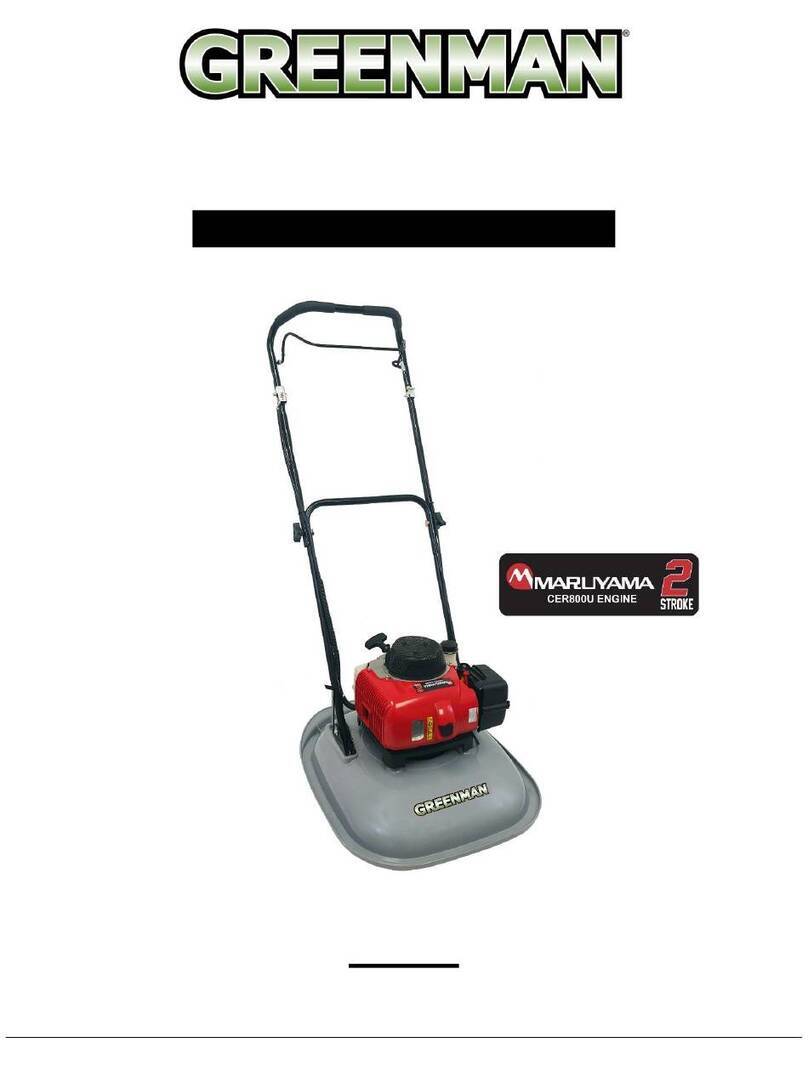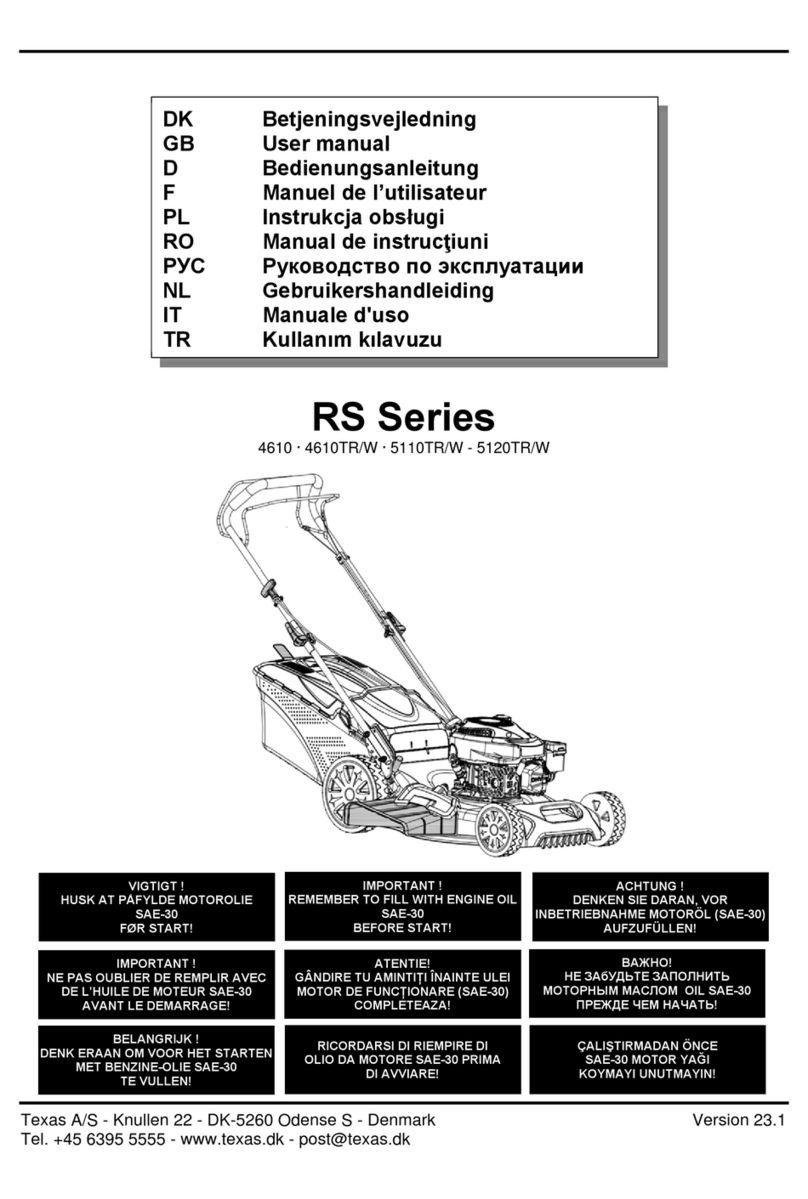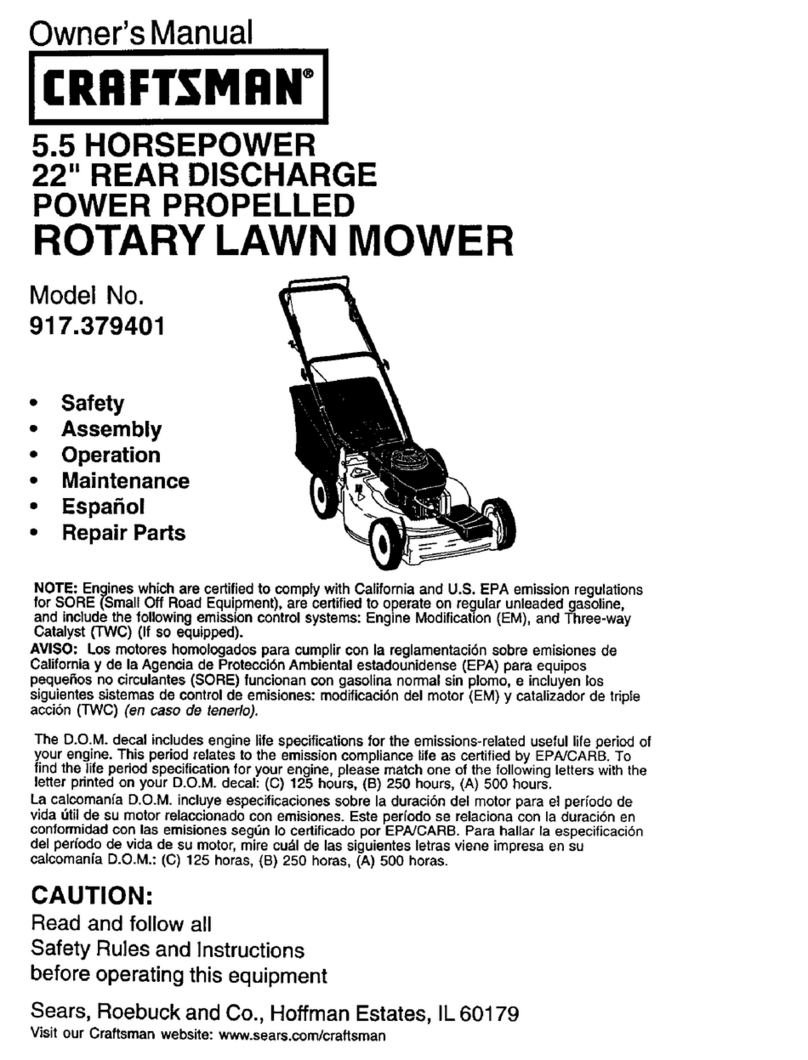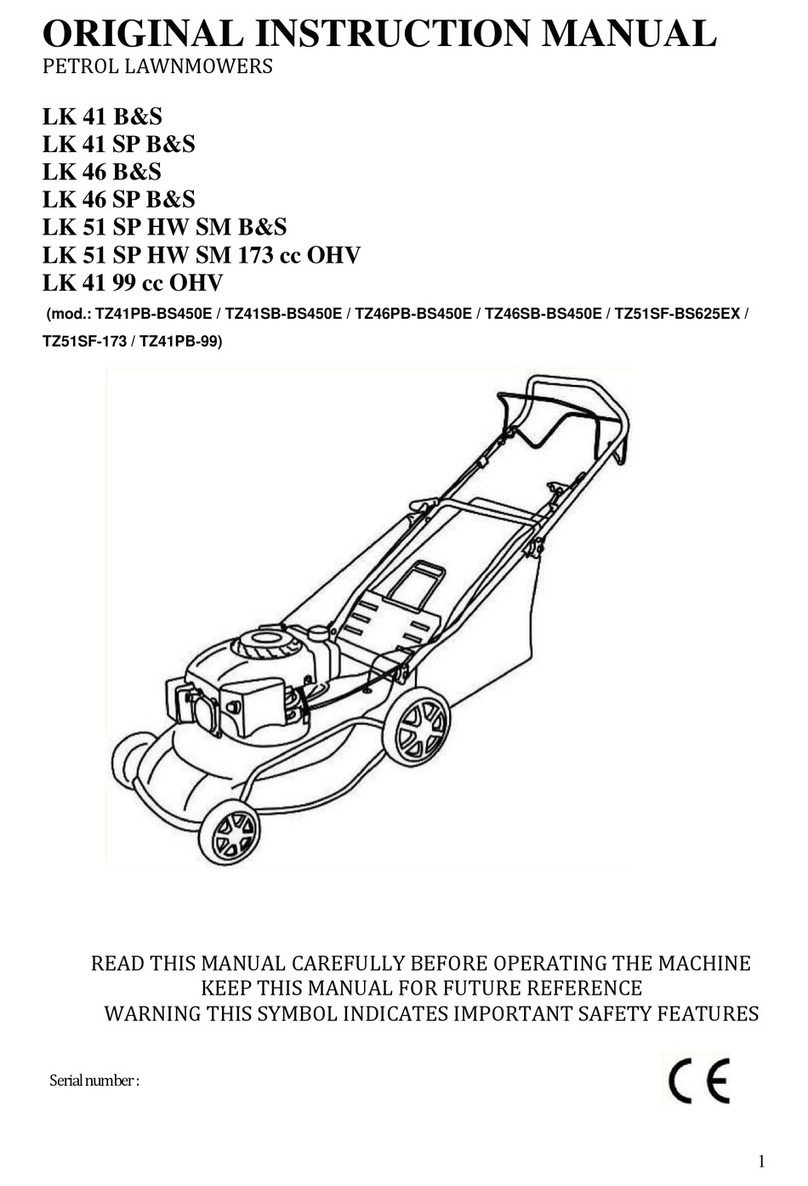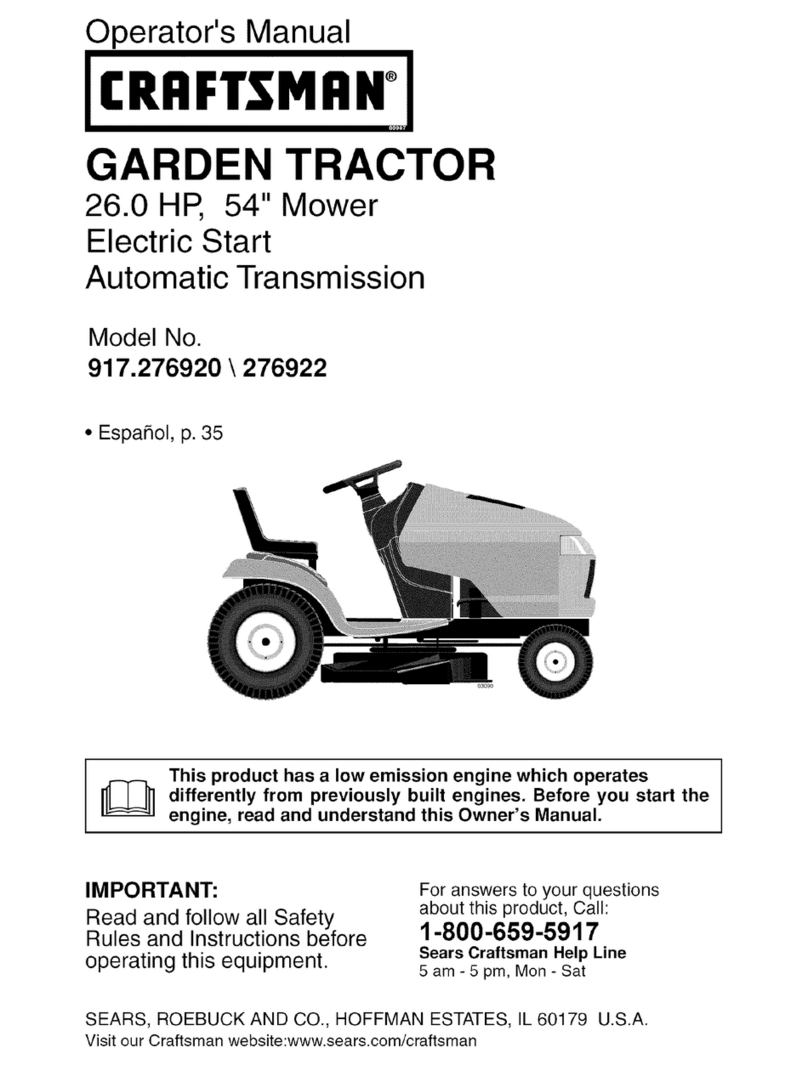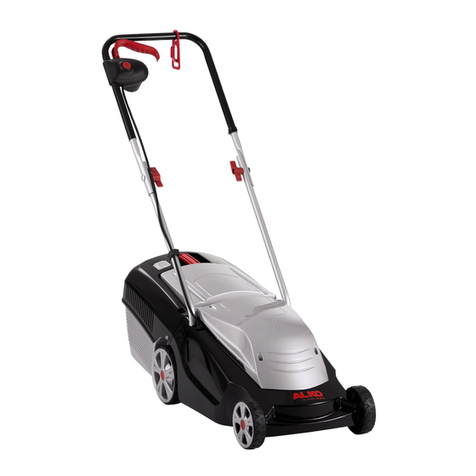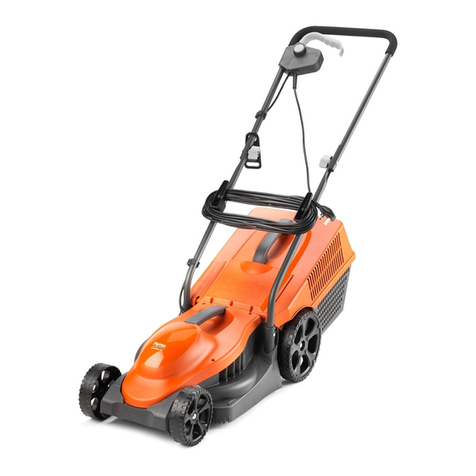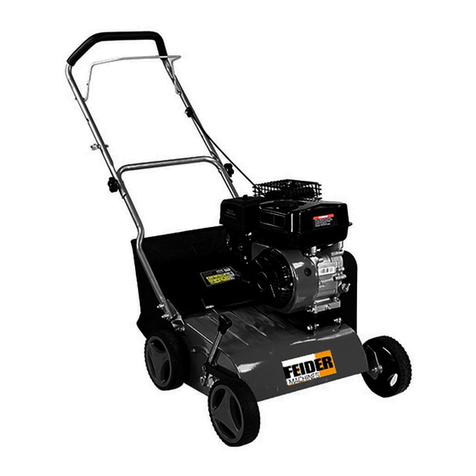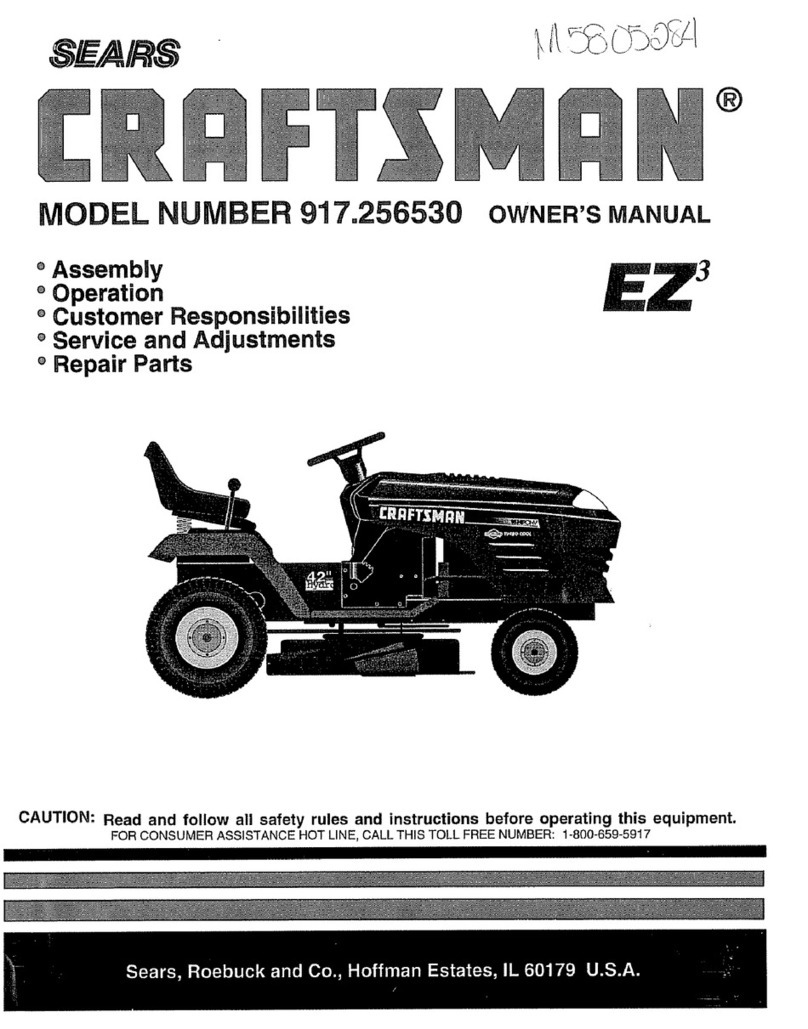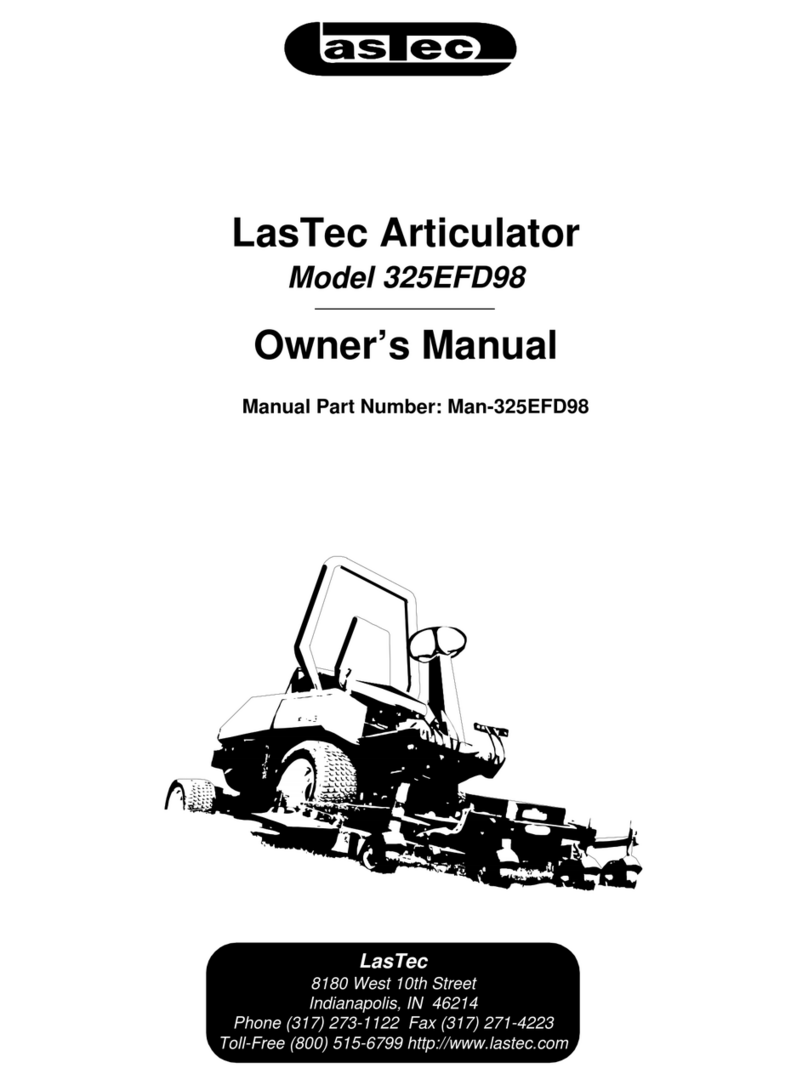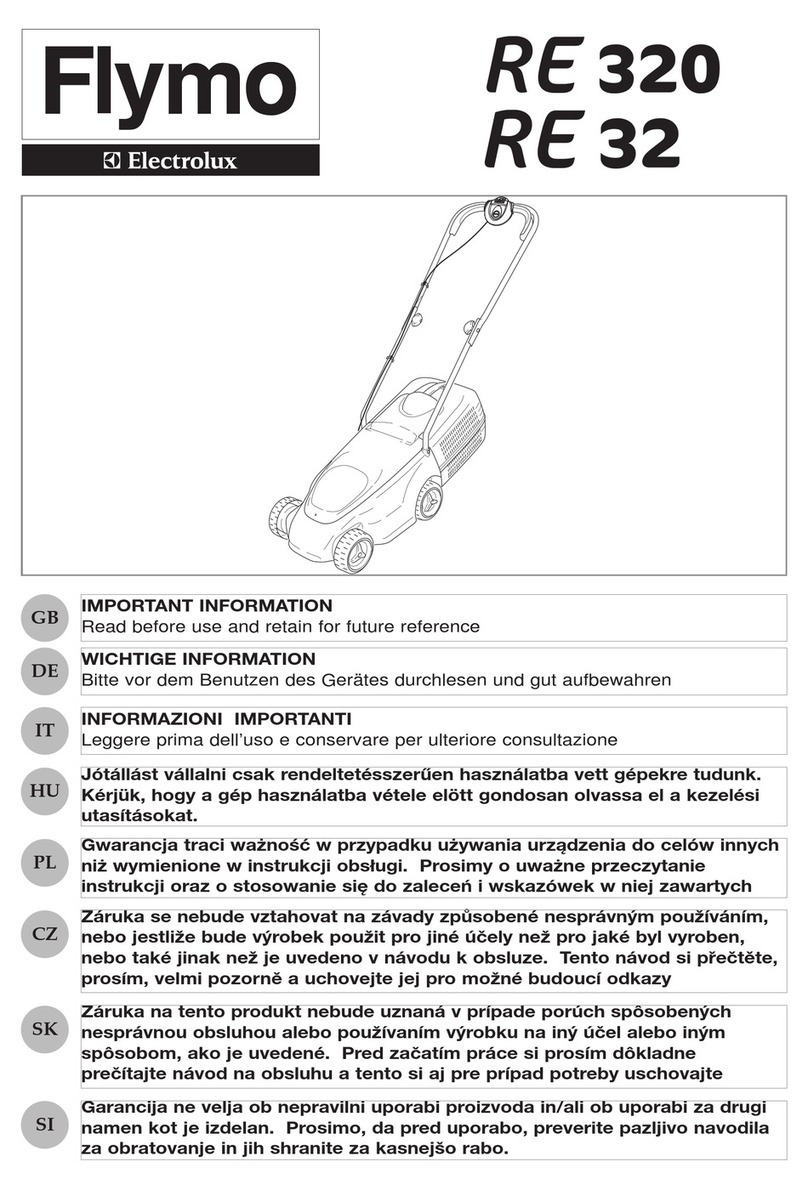GREENMAN 100 Series User manual

ZERO-TURN MOWER
OPERATOR’S MANUAL
100SERIES
MODELS
:
GMZT42RL
Jul.31 ,2020

General Information
Thank you for choosing GREENMAN as your preferred lawn mowing machine.
This owner’s manual contains information on safety instructions, assembly requirements, operation
instructions and maintenance requirements to assist you in the correct use of the machine.
The manual also contains information on adjustment settings and troubleshooting procedures should you
require them.
We advise that you read this manual in its entirety before operating the units performance features, assembly
and maintenance requirements,to ensure that you prolong the life of your machine and promote quality and
maximum efficiency.
As whit all mechanical equipment ,your machine will require cleaning and upkeep,remembering that it’s
important to regularly lubricate the machine as specified in the manual.
If the owners manual becomes lost or damaged in any way,please ensure that you seek a replacement copy
immediately by contacting our sales department.
If additional information is required please contact our sales department.[or your preferred dealer]
The illustrations and data used in this manual were current at the time of printing.
However due to possible in-line production changes,your machine may vary slightly in detail.
The manufacturer reserves the right to make changes or add improvements to its products at any time without
incurring any obligation to make such changes to previously manufactured products.
IMPORTTANT
This machine is a ride-on, rotary-blade lawnmower intended to be used by homeowners in residential
applications. It is primarily designed for cutting grass on well-maintained lawns. It is not designed for
cutting brush, mowing grass and other growth alongside highways, or for agricultural uses.But it also
should be treated carefully as such,any misuse or mistreatment of the machine may result in death or
serious injure to the operator.Any mishandling or misuse of the machine may result in direct damage to
the machine.It is the responsibility of the operator to practice safe handing of the machine at all times
and adhere to the safety instructions outlined in the manual to avoid death or serious injure or damage
to the machine.

I
CONTENTS
SPECIFICATIONS.........................................................................................................................................- 1 -
1. SAFETY SYMBOLS ...............................................................................................................................- 2 -
2. SAFETY DECALS...................................................................................................................................- 2 -
3. SAFETY INFORMATION.......................................................................................................................- 5 -
3.1. Trainings..........................................................................................................................................- 5 -
3.2. Preparation.......................................................................................................................................- 5 -
3.3. Fuel Handling Safety.......................................................................................................................- 5 -
3.4. Operational Safety...........................................................................................................................- 6 -
3.5. Maintenance Safety.........................................................................................................................- 7 -
3.6. Storing Safely..................................................................................................................................- 7 -
4. ASSEMBLY INSTRUCTIONS................................................................................................................- 8 -
4.1. Uncrate Mower................................................................................................................................- 8 -
4.2. Install Seat.......................................................................................................................................- 8 -
4.3. Install Steering Lever.......................................................................................................................- 8 -
4.4. Install Discharge Chute ...................................................................................................................- 8 -
4.5. Service Battery ................................................................................................................................- 9 -
4.6. Service Engine.................................................................................................................................- 9 -
5. OPERATION.............................................................................................................................................- 9-
5.1. Controls And Switches ....................................................................................................................- 9 -
5.2. Pre-Start Check List ......................................................................................................................- 11 -
5.3. Mounting And Dismounting The Mower ......................................................................................- 12 -
5.4. Starting The Engine.......................................................................................................................- 12 -
5.5. Cold Weather Starting Tips............................................................................................................- 13 -
5.6. Steering Lever Operation...............................................................................................................- 13 -
5.7. Mowing .........................................................................................................................................- 15 -
5.8. Uneven Terrain..............................................................................................................................- 16 -
5.9. Stopping The Engine.....................................................................................................................- 17 -
5.10. Transporting Machine..................................................................................................................- 17 -
5.11. Loading Machine.........................................................................................................................- 17 -
5.12. Storing Safely..............................................................................................................................- 17 -
6. MAINTENANCE...................................................................................................................................- 18 -
6.1. Check Engine Oil Level ................................................................................................................- 18 -
6.2. Lubrication ....................................................................................................................................- 18 -
6.3. Capacities ......................................................................................................................................- 19 -
6.4. TireAir Pressure............................................................................................................................- 19 -
6.5. Crankcase Oil And Air Filter.........................................................................................................- 19 -
6.6. Battery Maintenance......................................................................................................................- 19 -
6.7. Deck Cleaning...............................................................................................................................- 19 -
6.8. Blade Inspection............................................................................................................................- 20 -
6.9. Blade Removal ..............................................................................................................................- 20 -
6.10. Blade Sharpening.........................................................................................................................- 20 -
6.11. Balancing the Mower Blades.......................................................................................................- 20 -

II
6.12. Blade Installation.........................................................................................................................- 21 -
7. ADJUSTMENTS....................................................................................................................................- 21 -
7.1. Cutting Height Adjustment............................................................................................................- 21 -
7.2. Deck Leveling Adjustment............................................................................................................- 22 -
7.3. Deck Belt Adjustment....................................................................................................................- 22 -
7.4. Dump Drive BeltAdjustment........................................................................................................- 23 -
7.5. NeutralAdjustment. .......................................................................................................................- 23 -
7.6. Seat Adjustment.............................................................................................................................- 23 -
7.7. Parking BrakeAdjustment.............................................................................................................- 24 -
8. TROUBLESHOOTING...........................................................................................................................- 24 -

- 1 -
SPECIFICATIONS
Machine Model
GMZT42RL
Engine
Engine Type
BRIGGS&STRATTON
Model No.
40S877
Net Power
14.91Kw
Displacement
656cc
No-load r.p.m.
3600r/min
Starter
Electric
Electric
Electrical System
Safety interlocked
Deck Drive
Electric clutch
Drive System
EZT
Steering
Dual levers independently control speed and direction of travel
Zero turning radius
Speed
Forward (variable)
0 to 7mph. (11.3 km/h)
Backward (variable)
0 to 3.4mph. (5.5 km/h)
Fuel Tank Capacity
3.5U.S. gal. (13L.)
Tire Sizes
Drive Wheels
18×7.5-82 ply rated
Front Wheels
11×4-5 4 ply rated
Dimensions of Tractor
Seat Back Height
37.5"(0.95m)
Seat Cushion Height
26.5"(0.6m)
Tractor Width
(No Discharge Chute)
44.3"(1.1m)
Tractor Length
68.1"(1.73m)
Wheel Base
33.9"(0.86 m)
Weight - Uncrated
496 lbs. (225 kg.)
Weight - Crated
650 lbs. (295 kg.)
Cutting
Cutting Height
1-4"( 2.5-10 cm)
Cutting Width
42"

- 2 -
SAFETY SYMBOLS
This SAFETY ALERT SYMBOL is used
both in this manual and on the machine to
alert you to important safety messages which
must be followed to avoid accidents. This
symbol means:ATTENTION! BECOME
ALERT!
The safety alert symbol is to alert you to the
unsafe action or situation andis accompanied
by the word
DANGER, WARNING, or CAUTION.
Failure to observe the safety instructions
WILL result in death or serious injure.
Failure to observe the safety instructions
COULDresult in death or serious injury.
Failure to observe the safety instructions
COULDresult in minor or moderate injury.
SAFETY DECALS
All DANGER, WARNING, CAUTIONand
instructionalmessages on your machine
should be carefully readand obeyed.
Personal injury can result when
theseinstructions are not followed. The
information is for yoursafety and it is
important! The safety decals below are
onyour machine.The position of decals
refer to Figure 1 and Figure 2.
Keep all safety decals legible. Remove
allgrease, dirt, and debris from safety
decalsand instructional labels.
Figure 1
Figure 2
Safety decals must be replaced if they
aremissing or illegible.
When new components are installed, be
sure that current safety decals are affixed to
the replaced components.
New safety decals may be obtained from
Yourauthorizedequipmentdealerordistribut
or .
Familiarize yourself with the following
safety decals and instruction labels. They
are critical for the safe operation of your
machine.
DANGER:
CAUTION:
WARNING
::

- 3 -
6069370
Besides The Fuse
6069922 6069923
On The Front Fender,LH&RH
6069750 6069760
Behind Of The Rear Wheel,LH&RH
6069921
On The Console
6069927
On The Console
6069430
Rear Of The Shield,LH&RH
6069680
On The Tank
6069926
On The Carrier Ratchet
6069730
On The Front Of Deck,42''
6069700
On the mower deck

- 4 -
6069420
Besides The Belt Shields,LH&RH
6069410
On The CHUTE
6069450
Besides The Belt Shields,LH&RH
6969925
On The Left Side Of The Frame
6069770 6069460
On the seat bracket On the footboard

- 5 -
SAFETY INFORMATION
The safety of this machine relies on it being
operated within the conditionsthat
explained in this manual. Please read the
manual carefully before operating. Make
sure the operator is thoroughly familiar
with the safety rules.
Trainings
Regard the machine as a piece of power
equipment, so any person who operates the
machine MUST be trained and capable of
the safe operation of the equipment and
controls.
Know your controls and how to stop the
machine, engine and mower deck in an
emergency.
To avoid accident or injury, DO NOT allow
anyone to operate this machine without
reading the instruction.
Never allow young children,or unqualified
individuals to operate the equipment.
Keep young children and pets,away from
the zone of operation to avoid accidents or
hazards to other people or their property.
Preparation
While mowing,always wear tight and belted
clothing. Wear protected footwear. Never
operate the machine in barefeet, open toed
footwear .
Walk around machine and visually inspect
for damaged, loose, or missing components.
DO NOT operate unless all components are
properly installed, adjusted and in good
working condition.
Make sure all safety switches function
properly. See Operation section for details.
Make sure all safety shielding is in good
condition and properly installed.
Check brake action before you operate.
Adjust or check brakes as required.
Make sure all safety decals are installed and
in good condition.
Remove accumulated debris from machine
to avoid fire hazard.
Thoroughly inspect area to be cut and
remove stones, branches, wires and
accumulateddebris that might be thrown
causing personal injury or damage.
Evaluate the terrain to determine what
accessories and attachments are needed to
properly and safely perform the job.
Never permit any person, besides the
operator, to ride or operate the mower at any
time.
Operate only in daylight or good artificial
light.
Fuel Handling Safety
In certain conditions, gasoline is extremely
flammable and highly explosive. A fire or
explosion from gasoline can burn you and
others and can damage property.
Fill the fuel tank outdoors, in an open area,
when the engine is cold. Wipe up any
spillgasoline.
DO NOT fill the fuel tank completely full.
Add gasoline to the fuel tank until the level
of the filler neck. This empty space in the
tank allows gasoline to expand.
Never smoke when handling gasoline, and
keep away from open flames or where
gasoline fumes may be ignited by a spark.
Store gasoline in an approved container and
keep it out of the reach of children. Never
buy more than a 30-day supply of gasoline.
Always place gasoline containers on the
ground away from your vehicle before
filling.
DO NOT fill gasoline containers inside a
vehicle or on a truck or trailer bed, because
interior carpets or plastic truck bed liners
may insulate the container and slow the loss
of any static charge.
When practical, remove gas-powered
equipment from the truck or trailer and
CAUTION

- 6 -
refuel the equipment when its wheels are on
the ground
If this is not possible, then refuel such
equipment on a truck or trailer from a
portable container, rather than from a
gasoline dispenser nozzle.
If a gasoline dispenser nozzle must be used,
keep the nozzle in contact with the rim of
the fuel tank or container opening at all
times until fueling is complete.
Never use cellular phones or other portable
electronic devices when handling fuel.
Operational Safety
Read “Operation” section of this manual
before attempting to operate this machine.
DO NOT operate without ROPS (Roll Over
Protection System) deployed.
Fenders serve as shields. DO NOT operate
without them.
DO NOT drive machine without mower
deck installed. The proper stability of the
machine depends on the weight of the
mower deck.
Keep bystanders away from equipment
whist it is in operation.
Keep children and pets a safe distance.
Never directly discharge towards a person.
Start engine from operator’s seat after
disengaging PTO and placing steering
levers into the swing-out (neutral lock)
position.
Keep hands and feet away from underneath
mower deck while engine is running. Keep
clear of all moving parts on machine.
Wear suitable hearing protection devices to
protect engine noise.
DO NOT operate in backward unless
absolutely necessary and ensure the area
behind you is clear and safe.
DO NOT move steering levers from
forward to backward or backward to
forward position rapidly. The sudden
direction change may cause loss of control.
DO NOT operate on steep slopes greater
than 15 degrees.
DO NOT stop, start or change directions
suddenly on slopes.
Use extra care and maintain minimum
ground speed when traveling or operating
on a slope, over rough ground, or when
operating close to ditches and fences.
Keep alert for holes, rocks, roots and other
hidden hazards in the terrain. Keep away
from drop-offs and soft embankments.
Stop machine and mower deck immediately
while striking an obstruction or hard object.
Turn engine off, inspect machine and
mower deck. Repair any damage before
resuming operation.
Disengage PTO, stop engine, select park
brake, remove key and wait for all
movement to stop before dismounting,
making adjustments, cleaning, or
unclogging the machine.
Never transport mower with blades
running. Disengage PTO before crossing
streets, sidewalks, driveways, etc.
Watch for traffic when operating near or
crossing roadways.
This machine is not equipped for highway
use, especially when safety lighting and
marking is required. It is NOT a
recreational vehicle.
This unit is not equipped with a drawbar.
DO NOT pull loads.
Take all possible precautions when the
machine is unattended: disengage PTO,
lower mower deck, place steering levers in
neutral, set parking brake, stop engine and
remove key from ignition.
Never carry passengers.
DO NOT run engine in an enclosed area
without adequate ventilation. Exhaust gases
contain carbon monoxide,which is an
odorless and deadly poison.
Maintenance Safety
Always undertake maintenance with the
machine parked on a hard level surface;

- 7 -
with the engine stopped and the PTO
disengaged; with the park brake set; and
with the key removed from the ignition.
Always remove the grounded (-) clamp
from the battery when performing
maintenance on the engine, clutch, or any
other electrical system.
Always wear tight fitting clothing and
safety equipment when preforming
maintenance . Keep work area clean and
dry.
Never work under the machine without jack
stands or other equivalent safety blocks.
DO NOT depends solely on mechanical or
hydraulic jacks or lifts for support. Always
use adequate wheel chocks on tires
remaining on the ground.
If it is necessary to run an engine in an
enclosed area, remove the exhaust gases
from the area with an exhaust pipe
extension. If an exhaust pipe extension is
not available, work near the open doors and
windows.
Waste products such as used oil, fuel, and
batteries can harm the environment and
people. Dispose of waste products properly.
Never attempt to disconnect or alter any
part of the safety interlock systems.
DO NOT change engine governor settings.
Keep engine free of grass, leaves, or excess
grease to reduce fire hazard and minimize
engine overheating.
Keep machine and mower deck in good
operating condition and all safety devices in
proper place.
Periodically tighten all bolts, nuts and
screws. Check that all locking pins are
properly installed and in good condition.
Check brake operation frequently. Adjust
and service as required.
Storing Safely
Never store the machine with gasoline in
the tank inside a building where fumes may
reach an open flame, spark or pilot light as
on a furnace, water heater, clothes dryer, or
other gas appliance. Allow engine to cool
before storing .
If engine is to be unused for 30 days or
more, add a fuel stabilizer to the fuel
system. A fuel stabilizer is an acceptable
additive in minimizing the formation of fuel
gum deposits during storage. Add stabilizer
to gasoline in fuel tank or storage container.
Always follow mix ratio found on stabilizer
container. Run engine at least 10 minutes
after adding stabilizer to allow it to reach
the carburetor.
If draining fuel tank, drain fuel into an
approved container outdoors and away from
open flame.
Always provide adequate ventilation when
running engine indoors. Exhaust gases
contain carbon monoxide, which is an
odorless and deadly poison.
Remove all accumulated debris from
mower deck and tractor.
Sand areas where paint is chipped and
repair to prevent rust. Lubricate all
locations to prevent moisture damage
during storage.

- 8 -
ASSEMBLY INSTRUCTIONS
Uncrate Mower
Install Seat
Locate and align the seat with the seat pan
(Refer to Figure 3), torque all the nuts until the
seat is snug.
Figure 3
Install Steering Lever
4.3.1Loosen and remove the two bolts and
springs which attach to the control arm
shaft .
4.3.2 Place the lever on the outside of the
control arm shaft and secure with bolts
and washers (Refer to Figure 4),tighten
until snug. Repeat on opposite side of
unit.
NOTE: There are two lever height options
available. Place the levers in the first and the
second hole (from the top) to increase height
of the levers, or in the second and the third
hole(from the top) to decrease the height of
the levers.
Install Discharge Chute
Locate the discharge to the mower deck(Refer
to Figure 5) and tighten knob until chute is
snug.
Service Battery
Charging the battery may produce explosive
gases that can explode causing serious
injury.Keep sparks, flames, or cigarettes away
from battery.
4.5.1 Remove seat to gain access to the battery.
4.5.2 Check the voltage of the battery with
adigital voltmeter, Locate the voltage of the
battery in the table below and charge the
battery for the recommended time (Refer to
Table 1) interval to bring the charge up to a
full charge of 12.6Volts or greater.
IMPORTANT: Make sure the negative &
positive battery cables are correctly
connected , and the battery charger used
for charging the battery has an output of 16
volts and 7 amps or less to avoid damaging
the battery.
DANGER
Figure 5
Figure 4

- 9 -
Table 1
Voltage Reading
Percent Charge
Maximum Charger settings
Charging Interval
12.6 or greater
100%
16Volts/7 amps
No charging Required
12.4-12.6
75%-100%
16Volts/7 amps
30 Minutes
12.2-12.4
50%-75%
16Volts/7 amps
1 Hour
12.0-12.2
25%-50%
14.4Volts/4 amps
2 Hours
11.7-12.0
0-25%
14.4Volts/4 amps
3 Hours
11.7 or less
0%
14.4Volts/4 amps
6 Hours or more
4.5.3 Connecting the negative battery cables:
Note:If the positive cable is also disconnected,
connect the positive (red) cable to the positive
battery terminal first, then the negative (black)
cable to the negative battery terminal. Slip
insulator boot over the positive terminal.
Note: If time does not permit charging the
battery, or if charging equipment is not
available, connect thenegative battery cables
and run the vehicle continuously for 20 to 30
minutes to sufficiently charge the battery.
Battery contains sulfuric acid, avoid contact
and always shield eyes, face, skin and
clothing from battery ,cigarettes. Flames or
sparks could cause battery to explode.
DO NOT charge or use booster cables or
adjust post connection without proper
training.
If battery acid comes in contact with skin or
eyes then flush with water and call a
physician immediately.
Keep out of reach of children.
Service Engine
Engine is shipped with oil, check oil lever and
if necessary fill to the appropriate lever.
OPERATION
The safe operation of this machine is the
responsibility of the operator. Any person
who operates the machine MUST be
instructed in and capable of the safe operation
of the machine and all controls. Read all
safety information on pages 5 through 8.
Controls And Switches
Know your controls and how to stop the
machine, engine, and mower deck quickly in
an emergency. DO NOT operate this machine
until you are completely familiar with the
controls and comfortable with your ability.
We recommend you practice in a flat open
area at half throttle until you are comfortable
with all the controls.
The two Steering Levers control speed,
motion, and direction of the machine and are
located on each side of the seat. The left lever
controls flow of hydraulic oil from the left
pump to the left drive wheel motor. The right
lever controls flow of hydraulic oil from the
right pump to the right drivewheel motor. This
allows left and right drive wheels to turn
independently, which provides the “zero turn”
ability. Each lever has two positions: The
swung “out” neutral lock position, where the
lever will not activate the pump; and the
swung “in” operation position, where the
lever will activate the pump.
The following controls are located on or
beside the Operator’s Console which is
located to the right side of the seat. Refer to
Figure 6.
The Ignition Switch (A) is the key switch
CAUTION

- 10 -
located on the console. The ignition switch
is used to start and stop the engine. The
switch has three positions OFF, ON and
START. Insert the key into the switch and
rotate clockwise to the ON position.
The Choke Control (B) is the black knob on
the console.Choke control is used to aid in
starting a cold engine.Put the Choke control
up or down can control the opening degree
of the engine choke,the higher the knob
is,the wider choke will be.
The Throttle Control (C) is the large black
lever located beside the console to the right
of the seat. The throttle is used to control
engine speed. Move the throttle lever
forward to increase engine speed and
backward to decrease engine speed.
The PTO Switch (D) is the red push/pull
knob located on the console. Pull PTO knob
“up” to engage the electric clutch that
drives the belt connected to the mower deck
that driving the cutting blades. Push the
PTO knob “down” to disengage the electric
clutch that stops the blades from turning
within a few seconds.
The Electric Change and Hour Meter (E) is
the number indicator located on the
console. The meter is connected to the
ignition circuit and is provided to record the
number of hours the engine runs. If the
ignition switch is left on, without the engine
running, the hour meter will continue to
record. The meter is also connected to the
battery and is provided to show the
remaining power of the battery.
When the levers are centered in the
T-slot,the drive system is in the neutral
position.With levers moved out in the
T-slot,the drive system is in the parking
brake position.See Figure 7.
Figure 7
Several Safety Switches are incorporated in
this machine’s design to prevent the engine
from being started in certain conditions and
to cease the running engine in certain
conditions. These circuits should be checked
before each operation to ensure they are
working properly. See page 12 for check list
on these circuits.
The Start Circuits will keep engine from
starting unless:
Both steering levers are swung out in their
neutral locked position, and the PTO switch
is down in it’s disengaged position.
The Kill Circuits will stop the running engine
if:
The operator comes off the seat any time
during operation of the machine with PTO
engaged or steering levers in operating
position.
The steering levers are in their operating
position and the park brake lever is moved
into engaged locked (up) position.
DO NOT operate this machine unless all
WARNING
:
Figure 6

- 11 -
safety systems are working properly as
described above.
Pre-Start Check List
Maintain desirable operational standards and
help ensure the safety of the operator by
routinely checking the following on a daily
basis:
Walk around the machine and visually
check for loose or missing components.
Make sure all components are mounted
properly and are in good working condition.
Make sure all fenders, guards and shields
are safely and securely attached.
Make sure the discharge shield or
restriction plate is installed at the discharge
opening on the mower deck.
Make sure all safety decals are clearly
readable (see page 3 to 5).
Check hydrostatic transmission fluid level.
DO NOT operate machine with low fluid.
Low fluid could cause damage to
transmission and loss of control of the
machine.
Check for oil and fuel leaks.
IMPORTANT
When mowing in dusty conditions, dry
grass or long grass, it may be necessary to
frequently clean air intake screen to
prevent engine overheating.
Check air cleaner (refer to “Engine
Manual”). When mowing in dusty
conditions, dry grass or long grass, it may
be necessary to frequently clean the air
cleaner cartridge.
Make sure the engine is free of dirt and
debris.
Check fuel level. Make sure fuel is enough .
DO NOT fill fuel tank while engine is
running. Allow engine to cool two minutes
before adding fuel. If fuel is spilled, DO
NOT start engine and avoid creating a
source of ignition until the fuel is wiped
clean and evaporated.
Check tire pressure (see page 18 to 19).
Improper pressure will adversely affect
traction, steering and level cutting height.
Check tires for damage or cracking.
Check hydrostatic pump drive belt for
damage or cracking.
Check mower deck belt for damage or
cracking.
Check mower deck level.
Check to ensure blades are sharp and
secure; the cutting edge should be
positioned in the direction of blade rotation
(clockwise as viewed from top of mower
deck).
Adjust cutting height if necessary.
Check operation of park brake.
Remove grass and debris from machine.
Test safety interlock systems (Refer to
Table 2). Perform these tests in a clear open
area and keep bystanders away. If there is a
malfunction during one of these procedures,
DO NOT operate machine. (See your
GREENMANdealer).
Table 2
DANGER

- 12 -
Mounting And Dismounting The Mower
Always mount and dismount the mower from
the left side, with the brake on, the PTO
disengaged (down), the engine off, and the
steering levers in their swung out (neutral
lock) position. Mount the mower by stepping
from the ground to the left side of the deck
with your right foot, then step over the frame
to the footrest with your left foot. Always
keep the top of the deck and footrest clean and
dry. Wait for all moving parts to stop before
dismounting. Dismount the mower by
standing up on the footrest, then turn to the
left and step from the footrest, over the frame,
to the left side of the deck with your right foot,
and then step to the ground with your left foot.
The left steering lever can be used to stabilize
your movement; however, it is not strong
enough to support all your weight. Never
leave the mower unattended with the key in
the ignition.
Starting The Engine
Never start the engine in confined rooms.
Exhaust gases contain carbon monoxide,
an odorless and deadly poison.
DO NOT allow children to approach the
machine while the engine is running.
DO NOT operate the machine around open
flames .
DO NOT operate the engine when an odor
of fuel is present or other explosive
conditions exist.
5.4.1Position yourself on the tractor seat.
5.4.2 Engage the park brake.
5.4.3 Place both steering levers in neutral
lock position.
5.4.4 Place electric clutch switch(PTO) in
“OFF (down)” position.
5.4.5 Set the throttle at 1/3 open.
5.4.6 Insert the key into the ignition switch
and turn to “ON” .
5.4.7 Continue by turning the key to
Action
Left
Steering
Lever
Right
Steering
Lever
PTO
Switch
Parking
Brake
Proper
Result
Start Circuits
Trystarting engine
Out
Out
Off
On
Engines Cranks
Try starting engine
In
Out
Off
On
Engine will not crank
Try starting engine
Out
In
Off
On
Engine will not crank
Try starting engine
Out
Out
On
On
Engine will not crank
Kill Circuits (with engine running at 1/2 throttle)
Raise off seat
Out
Out
Off
On
Engine does not stop
Raise off seat
In
Out
Off
Off
Engine Stops
Raise off seat
Out
In
Off
Off
Engine Stops
Raise off seat
Out
Out
On
On
Engine Stops
Move left steering
lever in
Out
Off
On
Engine Stops
Moveright steering
lever in
Out
Off
On
Engine Stops
DANGER

- 13 -
“START”. When engine starts release key
immediately.
5.4.8 Warm the engine up at medium speed
for several minutes.
You will enhance the starter life by using short
starting cycles of several seconds. Engaging
starter motor more than 15 seconds per minute
can result in damage to starter.
Cold Weather Starting Tips
Use proper viscosity oil for temperature
expected (see “Engine Manual”).
Set throttle at half open.
A warm battery has better starting capacity
than a cold one.
Use fresh winter grade fuel. It is better for
winter starting than leftover summer grade
fuel.
Steering Lever Operation
DO NOT move steering levers from
forward to backward or backward to
forward position rapidly. Sudden direction
changes could cause loss of control or
damage to the machine.
Help prevent personal injury.Learn use of
the steering levers and practice at half
throttle until you become proficient and
comfortable with the operation of the
machine.
The steering levers control speed, motion and
direction of the machine. The steering levers
have two positions: (1) Neutral Lock, where
the lever(s) are swung completely outward
and cannot be moved front and back; (2)
Operating, where the lever(s) are swung in
and can be movedfront and back.
Neutral Lock Position:
Forward and backward movement of the
motion control levers is prevented when
levers are in the swung out (neutral lock)
position. Machine should not move with the
steering levers in the swung out (neutral
lock) position and the park brake released.
If machine does move, see “Neutral
Adjustment” section page 23.
Steering levers must be in the swung out
(neutral lock) position to start the engine.
Steering levers must be in the swung out
(neutral lock) position to safely enter and
exit the operator seat.
Operator can exit mower with the engine
running when the steering levers are in
theswung out (neutral lock) position, PTO
switch is disengaged, and the park brake is
engaged.
Operating Position:
Machine speed, motion and direction can be
controlled when the engine is running, park
brake is released, and steering levers are in
the swung in (operating) position.
Neutral:
When the steering levers are swung in and
centered front and back, they are in
operating (neutral). In operating (neutral),
the hydrostatic pumps do not deliver fluid
to the wheel motors.
Forward and backward Motion(Refer to
Figure 8):
Pushing both levers forward at the same
timewill move the machine forward.
Pulling both levers backwards at the same
time will move the machine in
backward..The further forward or backward
thesteering levers are moved, the faster the
machine will move in that direction.
CAUTION
WARNING
:

- 14 -
Figure 8

- 15 -
Turning(Refer to Figure 8):
While moving forward, turn gently right by
pushing the left lever further forward than
the right.
While moving forward, turn gently left by
pushing the right lever further forward than
the left.
Make a sharp turn right by pushing the left
lever forward and pulling the right lever
backward at the same time.
Make a sharp turn left by pushing the right
lever forward and pulling the left lever
backward at the same time.
DO NOT turn the machine by leaving one
lever in neutral and moving the other lever.
This will cause damage to the turf under the
tire that is not rotating.
Stopping:
To stop motion, move both steering levers
back to neutral. Machine is equipped with
springs to automatically return both levers to
neutral. If levers DO NOT automatically
return to neutral, see your authorized
GREENMANdealer for adjustment.
IMPORTANT
If you become confused during operation,
release both steering levers. They will
automatically return to the centered
neutral position and the machine will stop.
Mowing
Inspect area before mowing, picking up all
rocks, twigs and other debris. Enter new
areas carefully. Cut grass higher the first
time to allow mower to clear unseen
objects. Never assume an area is clear,
always check!
Clear mowing area when operating mower.
Flying objects could injure bystanders.
Before starting to machine, position the
machine in the area to be mowed withthe
mower deck set at the desired cutting
height. With the engine at half throttle, pull
up on the PTO switch knob to start the
blades turning. Accelerate to full throttle to
begin mowing.
To avoid serious injury or death from
flying objects or contact with blades,
NEVER operate mower without discharge
shield or restriction plate installed.
Keep hands and feet away from discharge
opening.
Before mowing, inspect the area to determine
the best mowing procedure. Consider height,
type of grass and terrain type (rolling, level or
rough).
Proper ground speed for mowing will depend
on the height, type and density of grass to be
cut. Normally, ground speed will range from
three to six miles per hour. Tall dense grass
should be mowed at a low speed, while thin
medium height grass can be cut at a faster
ground speed. Always operate engine at full
governed RPM when mowing. This is
necessary to maintain proper blade speed to
produce a clean cut.
Follow local recommendations for the
suitable cutting height in your area. Avoid
mowing grass too short to increase mowing
intervals. This may stress the grass during hot
weather and encourage weed growth during
the growing season.
Mow with uncut grass to the left. This will
distribute the clippings over the cut area.
Discharging clippings over the uncut area will
cause a grass buildup and may prevent
uniform cutting.
Remember that sharp blades produce cleaner
cuts and use less power.
Extremely tall grass should be mowed twice.
Cut grass higher first ,then cut the second time
DANGER
WARNING
:
WARNING
:

- 16 -
at desired height and 90°to the first pass.
Uneven Terrain
Be careful when operating mower on
uneven ground.
DO NOT operate on steep slopes.
Operation on a steep slope could cause loss
of control, machine to overturn and
personal injury or death.
DO NOT operate on steep slopes. This
machine was not specifically designed to
operate on steep slopes.
The operator is responsible for safe
operation on slopes. Only the operator can
determine the stability of the mower on a
given slope based on existing
conditionslike: machine speed and
direction, slope variation, slipperiness,
drop-offs, holes, obstacles, etc.
To determine stability on a slope, start at the
bottom and try to back the mower up the
slope slowly. If you cannot back up the
slope or if you feel uneasy on it, DO NOT
operate on it.
Always start mowing at the bottom of
slopes. Traveling up slopes, this machine
has more traction traveling forward than
backward. Be careful on slopes to avoid
driving forward into a position where there
is not enough traction to enable backing out
or stopping.
Tires may lose traction on slopes even
though the brakes are functioning properly.
Avoid sudden starts and acceleration when
traveling forward uphill as mower may tip
backwards.
DO NOT mow slopes when grass is wet
because slippery conditions will reduce
traction and braking which in turn affects
steering.
Use caution when making turns. Slow the
mower down before making sharp turns.
Unit can spin very rapidly by positioning
one lever too much ahead or behind the
other.
Look around you to be sure the area is clear
before turning or backing up.
Avoid starting or stopping on a slope. If
tires lose traction, disengage the blades and
proceed slowly straight down the slope.
Keep all movement on slopes slow and
gradual. DO NOT make sudden changes in
speed or direction.
Use extra care with grass catchers or other
attachments. These can change the stability
of the machine. DO NOT use grass catcher
on steep slopes.
DO NOT operate without ROPS deployed.
If machine is equipped with a fixed ROPS,
always wear seatbelt.
Wear seatbelt when mowing.
Be certain that the seatbelt can be released
quickly if the machine is driven or rolls into
ponds or water.
Check carefully for overhead clearances
such as, branches, doorways, or electrical
wires, before driving under any objects and
DO NOT contact themor contact them.
Stopping The Engine
5.9.1Set the throttle at 1/3 open. Allow
engine to idle at this setting for several
minutes, then move the throttle to slow idle.
5.9.2 Move ignition switch to “OFF”
position (upright) and remove key.
Always remove key from ignition switch
when leaving unit unattended or when not
in use.
Transporting Machine
Always back machine onto trailer to avoid
accidental upset.
Use a heavy- duty trailer to transport your
machine. Trailer must have signs and lights
required by law.
5.10.1 Raise mower deck to the transport
WARNING
:
CAUTION
This manual suits for next models
1
Table of contents
Other GREENMAN Lawn Mower manuals
